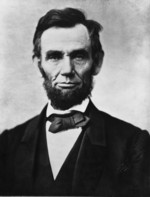Procedures & Applications:
Electing a Single Candidate by the Instant Runoff Procedure
Arguably, one of the most significant presidential elections in the history of the United States occurred in 1860. The instant runoff procedure is introduced using data from this election. The winner, Abraham Lincoln, became the 16th President of the United States of course, and he was at the helm during the U.S. Civil War (1861-1865). Lincoln also issued the Emancipation Proclamation on January 1, 1863 in which he declared that “all persons held as slaves … shall be free.” Would the election outcome have changed if the Voter Choice Act-House Resolution 2690 (supporting the adoption of the instant runoff procedure for single candidate elections) had been passed before 1860?
Would Lincoln have won?
 |
The 1860 election has been well-studied, because of its importance and
because the four viable candidates split votes according to geographical
boundaries. The candidates for presidency were Abraham Lincoln (Republican
from Illinois), John C. Breckenridge (Southern Democrat from Kentucky),
John Bell (Constitutional Unionist from Tennessee), and Stephen A. Douglas
(Northern Democrat from Illinois). In what follows, denote
Lincoln, Breckenridge, Bell, and Douglas by L, R, B, and D, respectively.
Recall that there are 24 possible ways that
voters can rank order four candidates without
ties. Because voters in a U.S. presidential election only vote for
one candidate, data from the 1860 election only indicates the number of
first-place votes that each candidate received. In his 1982 book Liberalism against Populism (Waveland Press, Inc., reissued 1988), political
scientist William H. Riker extrapolated from the 1860 data to arrive at
the following preferences for the voters (out of 99.96, close to 100 percent
of U.S. voters):

Under the instant runoff procedure, voters rank order the candidates. The winner of the election is determined through a series of rounds, by eliminating the candidate with the least number of first-place votes in each round. For the 1860 election data, Lincoln received 39.79 percent of the popular vote, Douglas received 29.36 percent, Breckinridge received 18.2 percent, and Bell received 12.59 percent. These tallies appear in the far right column in the above table. Because Bell received the least number of first-place votes, he is eliminated from the rankings (see the yellow entries in the following table.) As a demonstration of how the votes transfer, voters who rank B, L, D, and R, in that order, have their votes transferred to a preference ranking of L, D, and R. Similarly, those who rank the candidates D, B, L, and R have their votes transferred to D, L, and R.

Once Bell is eliminated from the rankings, then the voters’ preferences become:

The 45.56 percent of voters with preferences L, D, and R comes from eliminating B from the rankings below and the sum 0 + 9.59 + 30.2 + 5.77 = 45.56 of the percent of voters who now have the ranking L, D, and R.

Now that Bell has been eliminated, there is a new round that consists of an election between the remaining candidates: Lincoln, Douglas, and Breckinridge. Using the above preference rankings, the first-place votes are tallied for each candidate. Lincoln receives 45.56 + 0 = 45.56 first-place votes. Douglas receives 17.78 + 14.64 = 32.42 first-place votes. Breckinridge receives 0.66 + 21.32 = 21.98 first-place votes. Because no candidate receives a majority of the first-place votes, the candidate with the fewest first-place votes, Breckinridge, is eliminated in the second round. This amounts to deleting R from the preference data, as demonstrated below:

Lincoln’s 46.22 percent of the vote comes from adding 45.56, 0, and 0.66, while Douglas’ 53.74 percent of the vote comes from adding 17.78, 14.64, and 21.32. A third round of the election results in Douglas defeating Lincoln because Douglas receives a majority of the remaining votes. The election outcome under the instant runoff procedure would have resulted in Douglas being elected the 16th President of the United States, which may have prevented the Civil War and delayed freedom for the slaves. This highlights how a different election procedure can result in a different election outcome, even if the voters are consistent in the way that they vote.



